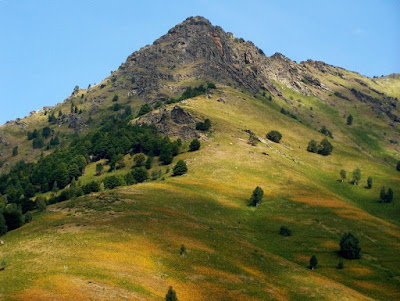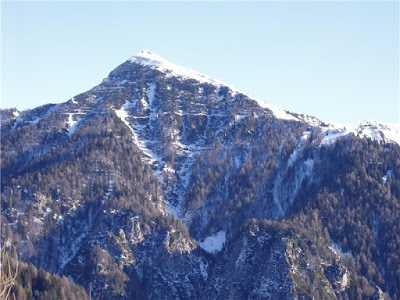Ok this is going to be fun. This amazing rock formation covered in snow is known as Babele. The name means "Grandmothers" and it's derived from Slavic (Serbian) "baba" meaning grandmother but also rock.
Here is the same rock formation just without snow.
It is located in Romania, on the Bucegi plateau which itself is located on Bucegi Mountains, part of the Southern Carpathian mountain chain...The name "Bucegi" is derived from the Slavic (Serbian) "buk" meaning beech tree. So the mountain name means "Beech mountains"...

The Babele rock formation is located near the mountain peak called "Baba Mare". The name is again derived from Slavic (Serbian) "baba" meaning "grandmother" or "rock" and Romanian mare meaning great, big...

Baba (Grandmother, Rock) is a common root for mountain peaks and rock outcrops in Balkan Slavic countries. I have collected quite a few of them in my article "Baba mountains and crags"
For instance Velika Baba (Big Grandmother, Big Rock) peak, Jezersko, Slovenia
If you thought that Babele rock formation is wow, how about this one, also located on the same Bucegi plateau...It is just like the sphinx in Egypt. Just organic...
Here is the same rock formation just without snow but with some sheep...
Bucegi plateau is located on the borders of three counties in Romania, all three with Slavic names:
Brașov-from "baras", fortress
Prahova-from "prag", doorstep, water cataract or "prah" dust
Dâmbovița-from "dămb" (dub), oak
List of Romanian counties and the etymologies of their names
The main pass through the Bucegi mountain range Bran pass, once marked by border crossings between Wallachia and Transylvania, and was defended by the Bran Castle, named after Bran village situates nearby. Bran is a Slavic (Serbian) word means "to defend"...
The castle is linked to Vlad III Dracula, better known as Vlad the Impaler, who was ruler of Wallachia on and off from 1448 to 1476. And an inspiration for the Bram Stoker's Count Dracula. Whether Vlad ever set foot to the Bran Castle is disputed and not really relevant to the theme of this article. What is relevant is that the name Vlad is Slavic and means Ruler.
Oh and there is a letter written by Vlad III's father Vlad II to the citizens of Brașov (Slavic name) in written in medieval Serbian, and a letter written by his uncle Aleksander to the citizens of Sibiu (Slavic name) in also written in medieval Serbian, and containing a very juicy Serbian curse still used today...I wrote about this this post "And those who lie"
Now...Back to the Babele rock formation. There is a legend linked to it. It goes like this:

This is interesting, considering that Baba is a Slavic word. And that Baba Dochia is basically Romanian version of South Slavic Baba Marta (Grandmother March), The Hag, Winter Earth, the spiteful old witch...Originally Baba Morana, the goddess of death...I wrote about this in my post "Gryla"...
In Romania there are three main legends related to Baba Dochia as Baba Marta, the Old Hag Winter Earth...
First legend says that Baba Dochia was a proud old woman who insulted the month of March either by badmouthing Him or by going up to the mountain with a herd of goats (way before she should, in May). March then borrows frosty days from February to punish her...
Interestingly in Serbian folklore, "babini jarci" (grandmother's goats) and "pozаjmenci" (borrowed days), both mean "cold stormy snowy days in March or April"...I wrote about this in my post "Gryla"...
Second legend goes like this:

The whole story is an allegory about the animosity between the old hag winter and the young maiden spring. Just like in these Irish and Slavic legends. I talked about this in my posts "The old woman of the mill dust" and "The Snow White"
Now in this legend, Baba Dochia's son's name is Dragomir, Slavic name meaning "The one who is very dear" . I wonder if this is euphemism for the sun, which is "very dear" as it is the sun that turns old hag winter earth into young maiden spring earth...
We have parallel to Dragomir (very dear)=Sun, Summer in Radegast (dear guest)=Sun, Summer
The wild strawberries are a summer fruit, ripening at the earliest at the end of May, beginning of June. May is the time when in the Balkans the flocks are moved to the highland pastures.
Which is why Baba Dochia, The Old Hag, Winter goes into the mountains with her flock of Goats when she sees that her daughter in law, Young Maiden, Spring brought the strawberries from the forest...
In the third legend Baba Dochia's son's name is partially Romanised to Dragobete. The legend goes like this:

In Serbia, traditionally, sheep were sheared twice. First time in February, when dirty wool between the legs and around the udder was sheared in preparation for lambing and suckling. This is the black dirty wool which was usually thrown away. The main shearing season is in May, after the lambing is over, and before the sheep are taken up to the mountain pastures. This is the clean white wool...
The sheared wool was washed in rivers before being dried and further processed. The washing of wool is the signal to take the flocks to the highland pastures...Which is why Baba Dochia, The Old Hag, Winter, sets off with her flocks up the mountain when she sees that her daughter in law, Young Maiden, Spring, have brought back home freshly washed white wool...
The reason why in one legend Baba Dochia goes up the mountain wearing 9 coats and in the other 12 coats, is this. There is a belief in Carpathian region of Romania, that the first 9 (in some parts 12) days of March are the "Baba days". This is the time when Baba Dochia can bring snowstorms and cold weather before the spring fully sets in.
There was also once a custom in the same region, for women to pick a day out of these Baba days, on the first of March. And if the day turns out to be fair, they'll be fair in their old days (when you are a baba yourself), and if the day turns out to be cold, they'll turn bitter when you get old (when you are a baba yourself).
Very interesting considering that Baba is a Slavic word meaning Grandmother. And that in Serbian folklore, "baba" (grandmother) also means changeable weather at the beginning of March when snow is likely to fall. And that in Serbian folklore, "bаbini dni" (grandmother's days) means cold stormy snowy days in March or April...I wrote about this in my post "Gryla"...
By the way, why is Baba Dochia called Baba Dochia? Apparently, the name originates from the Byzantine calendar, which celebrates the 2nd-century martyr-saint Eudokia of Heliopolis (Evdokia) on 1st of March...
I love this.
The name Eudokia comes from Greek Eudoxia (Ancient Greek: Εὐδοξία, Eudoxía), originally meaning "good fame or judgement" or "she whose fame or judgement is good". And on her day the judgement ritual is performed by women...Eudokia is from Heliopolis (the Sun City) and the Baba Dochia celebration is about the defeat of winter by the sun. St Eudocia was celebrated on the 1st of March, "because she was beheaded on that day" and the Slavic mythological equivalent of Baba Dochia, Baba Marta, is celebrated by the Balkan Slavs on the 1st of March...Well people celebrate the killing of winter...
How can such an importan Romanian folk character be basically Slavic, Serbian in origin? Well even the Romanian national hero, Iovan Iorgovan was, according to Romanian legends, of Serbian origin...
How come? Well someone had to give names to all the Slavic toponyms and Hydronyms in Romania...Huge number of Serbs once lived in the southern areas of Romania...They are, almost all, Romanised now, through a process organised and "encouraged" by Austor-Hungarian state...
All that's left are toponyms, hydronyms and legends...
































































































